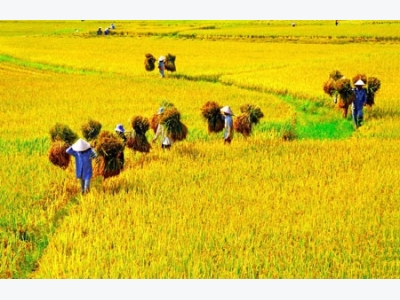Lifting of farmland limit to spur exports of produce

Expansion of land limits and accumulation of land for large-scale production are expected to be the foundation for the branding of farm produce.
Vietnam has become a big farm produce exporter, but most of the products are exported as raw materials and don’t bear a Vietnamese brand.
A report from the National Office of Intellectual Property (NOIP) shows that 80 percent of Vietnam’s farm exports are sold under foreign brands. In the domestic market, 80 percent of farm produce are sold without labeling.
Ministers of Agriculture and Rural Development Nguyen Xuan Cuong admitted that the quality of Vietnam farm produce is not always the same because of small-scale production. Tens of farm produce items have export turnover of $1 billion and more, but they are only exported as raw materials or preliminarily processed.
Expansion of land limits and accumulation of land for large-scale production are expected to be the foundation for the branding of farm produce.
The director of a tea export company in Lam Dong province said Vietnam is the fifth largest tea exporter in the world, but it can only pocket modest money because it mostly exports raw materials.
Meanwhile, companies in the UK and Taiwan, which import tea from Vietnam, process tea and sell under their labels, earning big money.
Similarly, Vietnam is also one of the biggest rice exporters, but Vietnamese brands are unknown in the world market. In China, Vietnam’s biggest export market, many people don’t know they are eating rice from Vietnam.
In fact, some farm produce items are recognized by the world as specialties of Vietnam, but Vietnam still cannot export products in large quantities.
The US has recognized Vietnam’s Lo Ren Star-apple and accepted to import the product. However, the exports remain modest because of the limited growing area.
Truong Thi Ngoc Anh, Vice Chair of Vietnam Fatherland Front Central Committee, said during her visit to Singapore, she saw familiar fruits, such as mango and pineapple, but they were all from Thailand.
Anh commented that Vietnam’s fruits still cannot penetrate choosy markets because they are produced by households on a small scale, which makes it difficult to control quality.
All analysts agree that Vietnam’s agriculture is organized on a small scale, therefore, it cannot approach modern production. In order to develop agriculture in a sustainable way, Vietnam needs to re-organize production on s large scale.
“Vietnam won’t gain success with 13.8 million farm households and 78 million small pieces of field,” Cuong said. “We must reorganize the agricultural production.”
Sharing the same view with Cuong, Nguyen Do Anh Tuan, head of the Institute for Agriculture Policies, said the biggest problem lies in the land policy.
If expanding the farmland limit and aggregating land, Vietnam will be able to organize large-scale agricultural production, which will help create high-quality products, thus paving the way for branding of Vietnam’s farm produce.
Có thể bạn quan tâm
 Temporarily imported meat and viscera products into Vietnam to be stopped
Temporarily imported meat and viscera products into Vietnam to be stopped After the price of pork dropped sharply at the beginning of 2017 to just 50% of the price in the same period last year
 New technology ups rice value in Cần Thơ
New technology ups rice value in Cần Thơ The installation of automated processing lines in a major rice mill is set to boost hi-tech marking in Cần Thơ City, officials say.
 Sharp rise in Q1 fertiliser imports
Sharp rise in Q1 fertiliser imports Việt Nam spent US$338 million to import 1.22 million tonnes of fertiliser in the first quarter of this year, up 31.5 per cent in volume and around 24 per cent